CHEVROLET CORVAIR 1965 2.G User Guide
Manufacturer: CHEVROLET, Model Year: 1965, Model line: CORVAIR, Model: CHEVROLET CORVAIR 1965 2.GPages: 56, PDF Size: 22.29 MB
Page 11 of 56
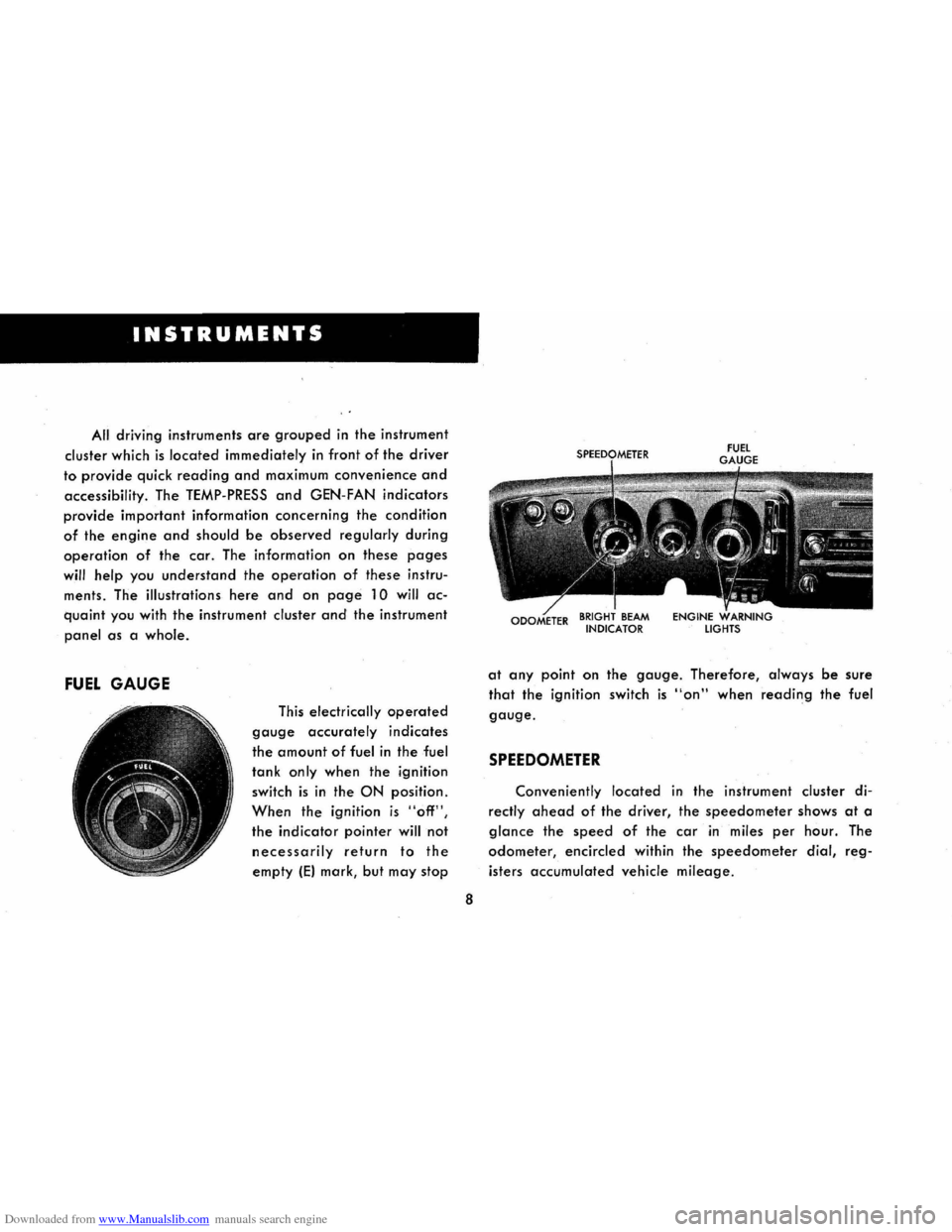
Downloaded from www.Manualslib.com manuals search engine INSTRUMENTS
All driving instruments are grouped in the instrument
cluster
which is located immediately in front of the driver
to provide quick reading and maximum convenience and
accessibility. The TEMP-PRESS and GEN-FAN indicators
provide important information concerning the condition
of the engine and should be observed regularly during
operation of the car. The information on these pages
will help you understand the operation of these instru
ments. The illustrations here
and on page 10 will ac
quaint you with the instrument cluster and the instrument
panel as a whole.
FUEL GAUGE
This electrically operated
gauge accurately indicates
the amount of fuel in the fuel
tank only when the ignition
switch is in the ON position.
When the ignition is "off",
the indicator pointer will not
necessarily return to the
empty IE) mark, but may stop
8
at any point on the gauge. Therefore, always be sure
that the ignition switch is "on" when reading the fuel
gauge.
SPEEDOMETER
Conveniently located in the instrument cluster di
rectly ahead of the driver, the speedometer shows at a
glance the speed of the car in miles per hour. The
odometer, encircled within the speedometer dial, reg
isters accumulated vehicle mileage.
Page 12 of 56
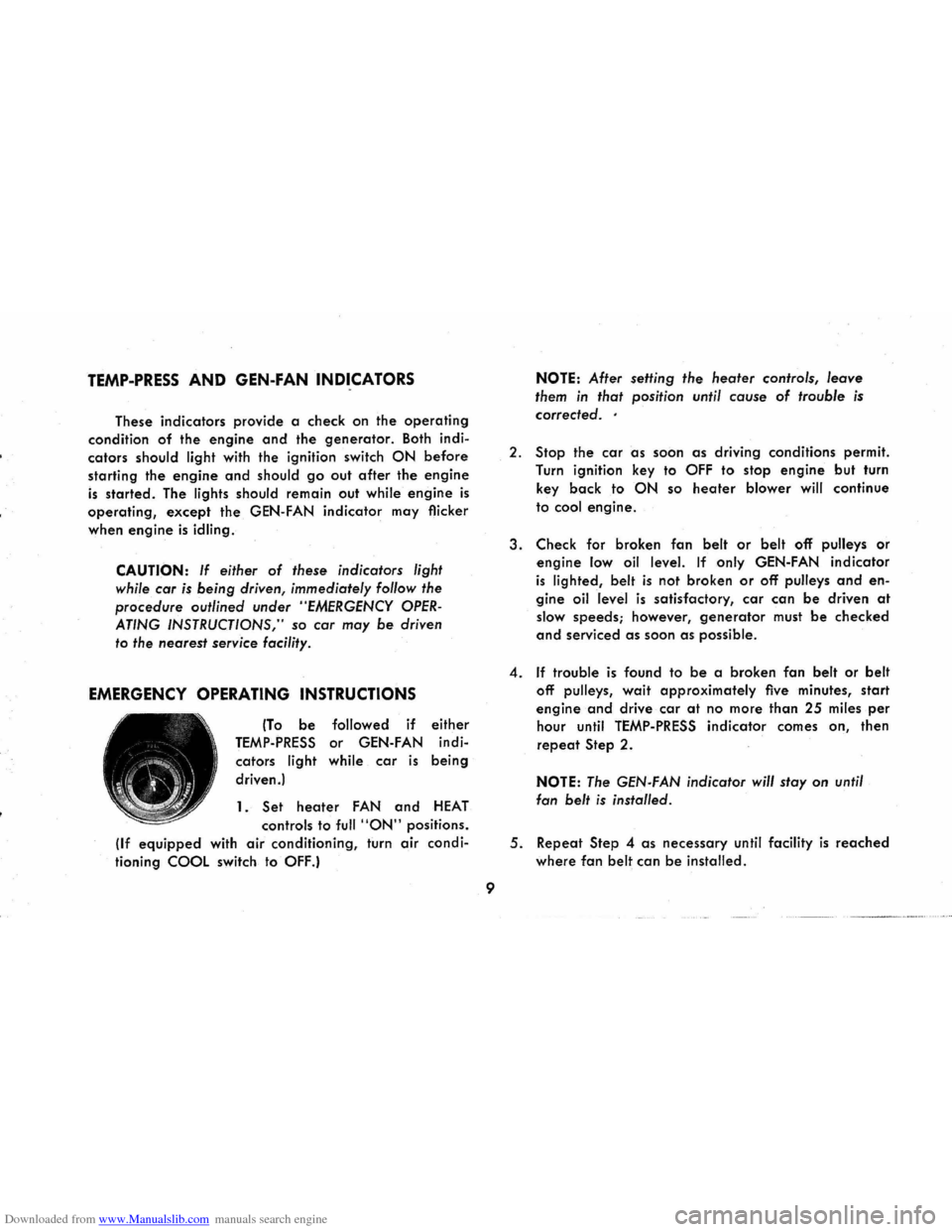
Downloaded from www.Manualslib.com manuals search engine TEMP-PRESS AND GEN-FAN INDICATORS
These indicators provide a check on the operating
condition of the engine and the generator. Both indi
cators should light with the ignition switch ON before
starting the engine and should go out after the engine
is started. The lights should remain out while engine is
operating, except the GEN-FAN indicator may flicker
when
engine is idling.
CAUTION: If either of these indicators light
while car is
being driven, immediately follow the
procedure outlined under "EMERGENCY OPER
ATING INSTRUCTIONS," so car may be driven
to
the nearest service facility.
EMERGENCY OPERATING INSTRUCTIONS
(To be followed if either
TEMP-PRESS or GEN-FAN indi
cators light while car is being
driven.)
1.
Set heater FAN and HEAT
controls to full "ON" positions.
(If
equipped with air conditioning, turn air condi
tioning COOL switch to OFF.)
9
NOTE: After setting the heater controls, leave
them in that position until cause of trouble is
corrected ..
2. Stop the car as soon as driving conditions permit.
Turn ignition key to
OFF to stop engine but turn
key
back to ON so heater blower will continue
to cool engine.
3. Check for broken fan belt or belt off pulleys or
engine low oil level. If only GEN-FAN indicator
is lighted, belt is not broken or off pulleys and en
gine oil level is satisfactory, car can be driven at
slow speeds; however, generator must be checked
and serviced as soon as possible.
4. If trouble is found to be a broken fan belt or belt
off pulleys, wait approximately five minutes, start
engine and drive car at no more than 25 miles per
hour until TEMP-PRESS indicator comes on, then
repeat Step 2.
NOTE: The GEN-FAN indicator will stay on until
fan
belt is installed .
5. Repeat Step 4 as necessary until facility is reached
where fan belt can be installed.
Page 13 of 56
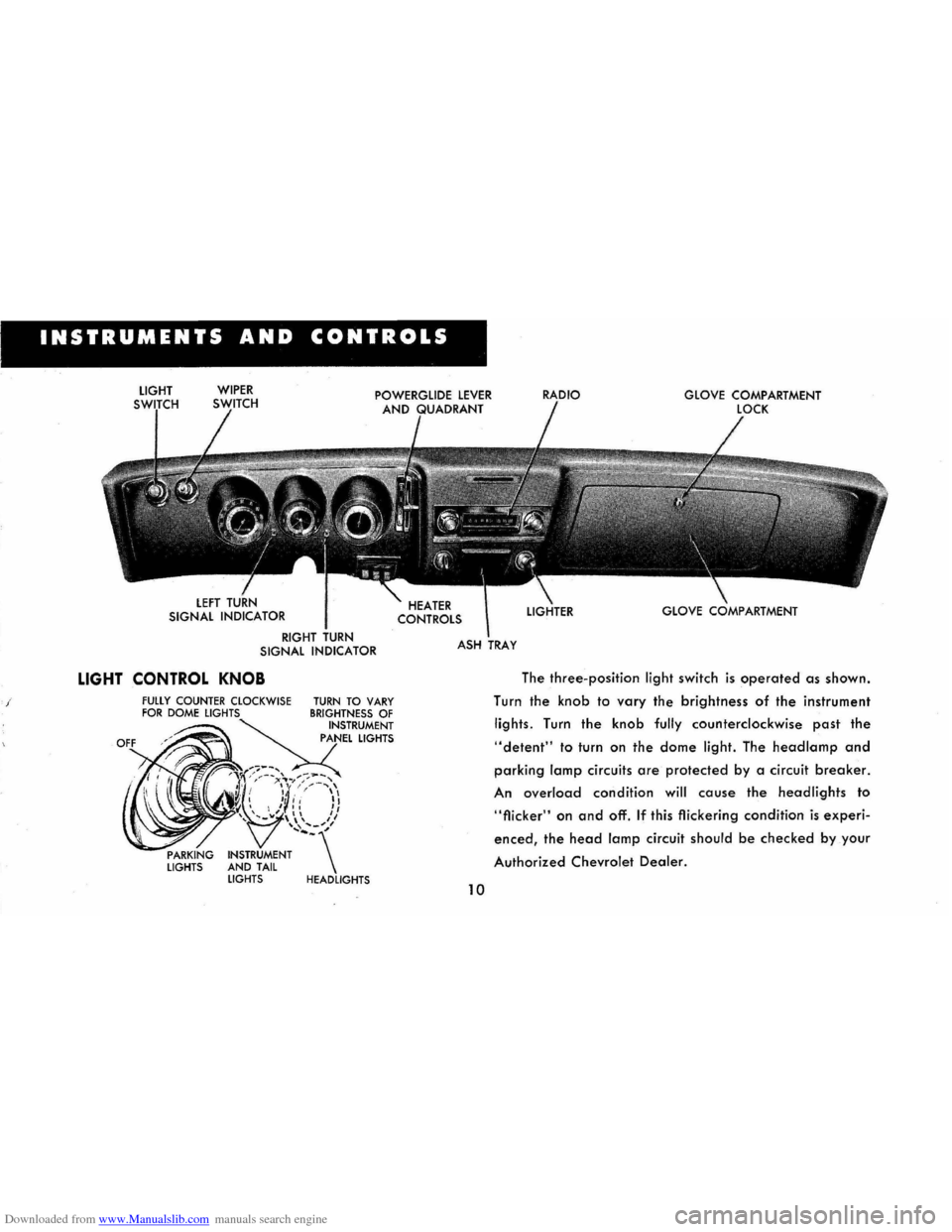
Downloaded from www.Manualslib.com manuals search engine I
INSTRUMENTS AND CONTROLS
LIGHT WIPER RIGHT
TURN SIGNAL INDICATOR
LIGHT CONTROL KNOB
PARKING LIGHTS
TURN TO VARY
LIGHTER
GLOVE COMPARTMENT
LOCK
GLOVE COMPARTMENT
ASH
TRAY
10
The three-position light switch is operated as shown.
Turn the
knob to vary the brightness of the instrument
lights. Turn the knob fully counterclockwise past the
"detent" to turn on the dome light. The headlamp and
parking lamp circuits are protected by a circuit breaker.
An overload condition will cause the headlights to
"flicker" on and off. If this flickering condition is experi
enced, the head lamp circuit should be checked by your
Authorized Chevrolet Dealer.
Page 14 of 56
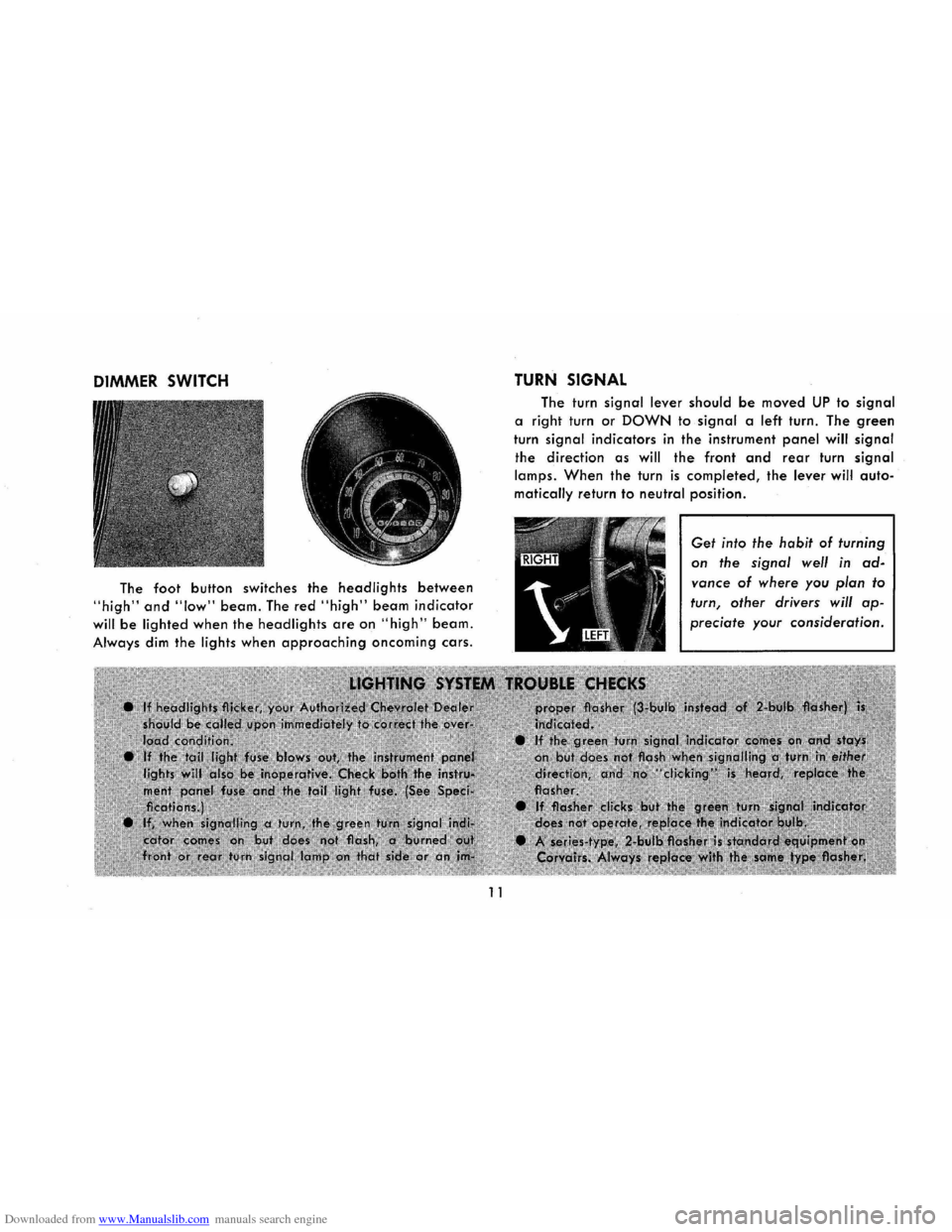
Downloaded from www.Manualslib.com manuals search engine DIMMER SWITCH
The foot button switches the headlights between
"high" and "low" beam. The red "high" beam indicator
will be lighted when the headlights are on "high" beam.
Always dim the lights when approaching oncoming cars.
11
TURN SIGNAL
The turn signal lever should be moved UP to signal
a right turn or DOWN to signal a left turn. The green
turn signal indicators in the instrument panel will signal
the direction as will the front and rear turn signal
lamps. When the turn is completed, the lever will auto
matically return to neutral position.
Get into the habit of turning
on the signal well in ad
vance of where you plan to
turn, other drivers will ap
preciate your consideration.
Page 15 of 56
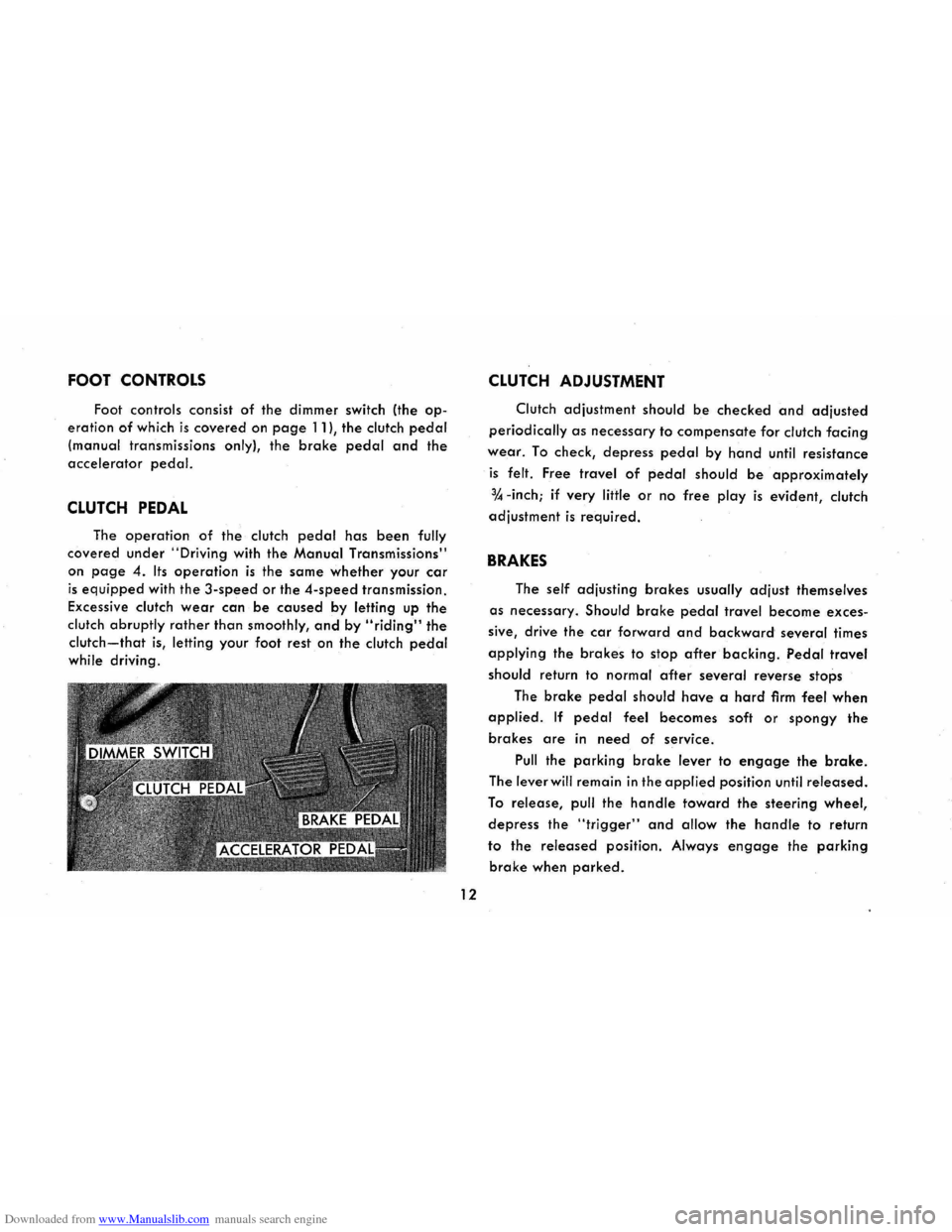
Downloaded from www.Manualslib.com manuals search engine FOOT CONTROLS
Foot controls consist of the dimmer switch (the op
eration of which is covered on page 11), the clutch pedal
(manual transmissions only), the brake pedal and the
accelerator pedal.
CLUTCH PEDAL
The operation of the clutch pedal has been fully
covered under "Driving with the Manual Transmissions"
on
page 4. Its operation is the same whether your car
is equipped with the 3-speed or the 4-speed transmission.
Excessive clutch
wear can be caused by letting up the
clutch abruptly rather than smoothly, and by "riding" the
clutch-that is, letting your foot rest on the clutch pedal
while driving.
12
CLUTCH ADJUSTMENT
Clutch adjustment should be checked and adjusted
periodically as necessary to compensate for clutch facing
wear. To check, depress pedal by hand until resistance
is felt. Free travel of pedal should be approximately
% -inch; if very little or no free play is evident, clutch
adjustment
is required.
BRAKES
The self adjusting brakes usually adjust themselves
as necessary. Should brake pedal travel become exces
sive, drive
the car forward and backward several times
applying the brakes to stop after backing. Pedal travel
should
return to normal after several reverse stops
The
brake pedal should have a hard firm feel when
applied. If pedal feel becomes soft or spongy the
brakes are in need of service.
Pull the parking brake lever to engage the brake.
The lever will remain in the applied position until released.
To release, pull the handle toward the steering wheel,
depress the "trigger" and allow the handle to return
to the released position. Always engage the parking
brake when parked.
Page 16 of 56
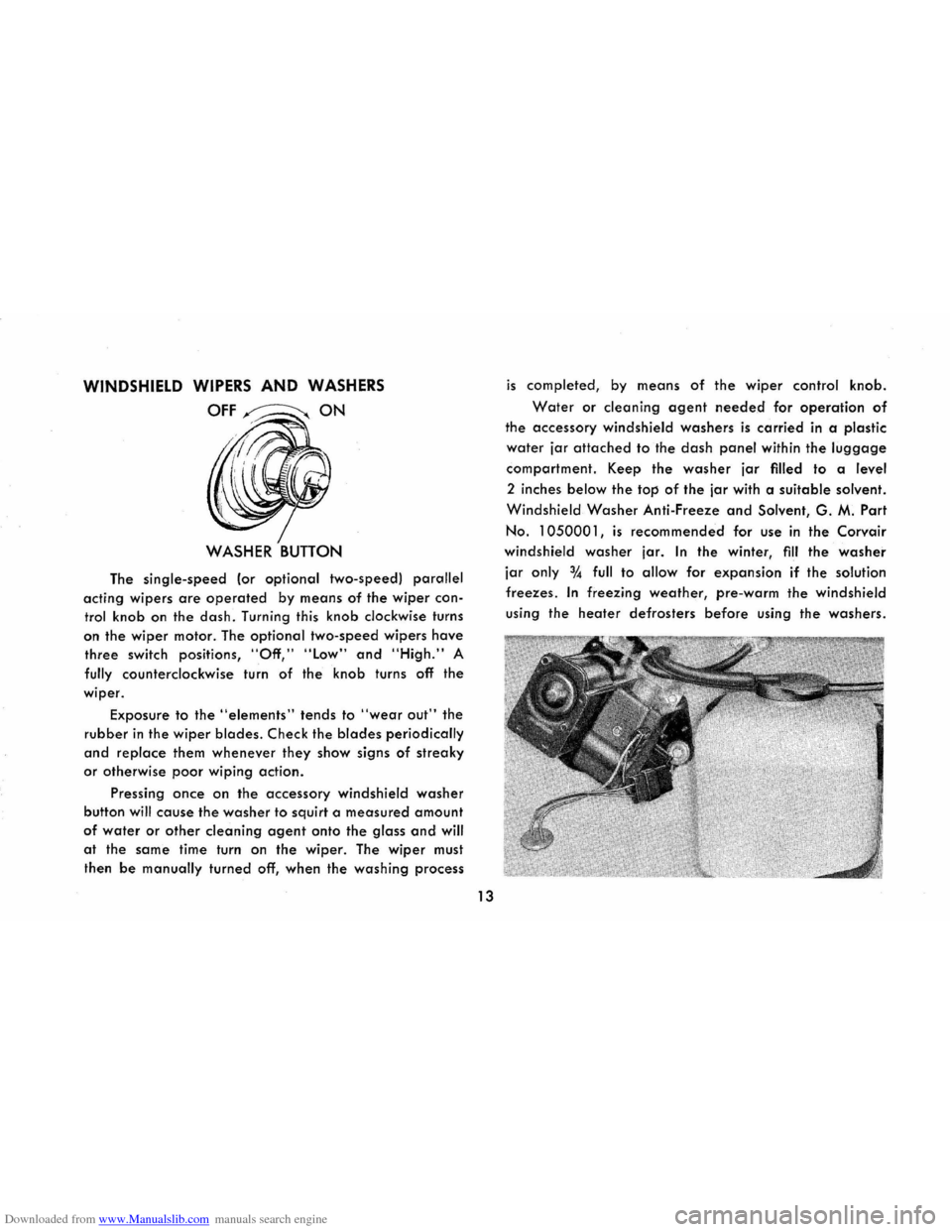
Downloaded from www.Manualslib.com manuals search engine WINDSHIELD WIPERS AND WASHERS
OFF~ON
The single-speed (or optional two-speed) parallel
acting wipers are operated by means of the wiper con
trol knob on the dash. Turning this knob clockwise turns
on the
wiper motor. The optional two-speed wipers have
three switch positions, "Off," "Low" and "High." A
fully counterclockwise turn of the knob turns off the
wiper.
Exposure
to the "elements" tends to "wear out" the
rubber in the wiper blades. Check the blades periodically
and replace them whenever they show signs of streaky
or otherwise poor wiping action.
Pressing once on the accessory windshield washer
button will cause the washer to squirt a measured amount
of water or other cleaning agent onto the glass and will
at the same time turn on the wiper. The wiper must
then
be manually turned off, when the washing process
13
is completed, by means of the wiper control knob.
Water or cleaning agent needed for operation of
the accessory windshield washers is carried in a plastic
water jar attached to the dash panel within the luggage
compartment. Keep the washer jar filled to a level
2 inches below the top of the jar with a suitable solvent.
Windshield Washer Anti-Freeze and Solvent, G. M. Part
No. 1050001, is recommended for use in the Corvair
windshield washer jar. In the winter, fill the washer
jar only 3,4 full to allow for expansion if the solution
freezes. In freezing weather, pre-warm the windshield
using the heater defrosters before using the washers.
Page 17 of 56
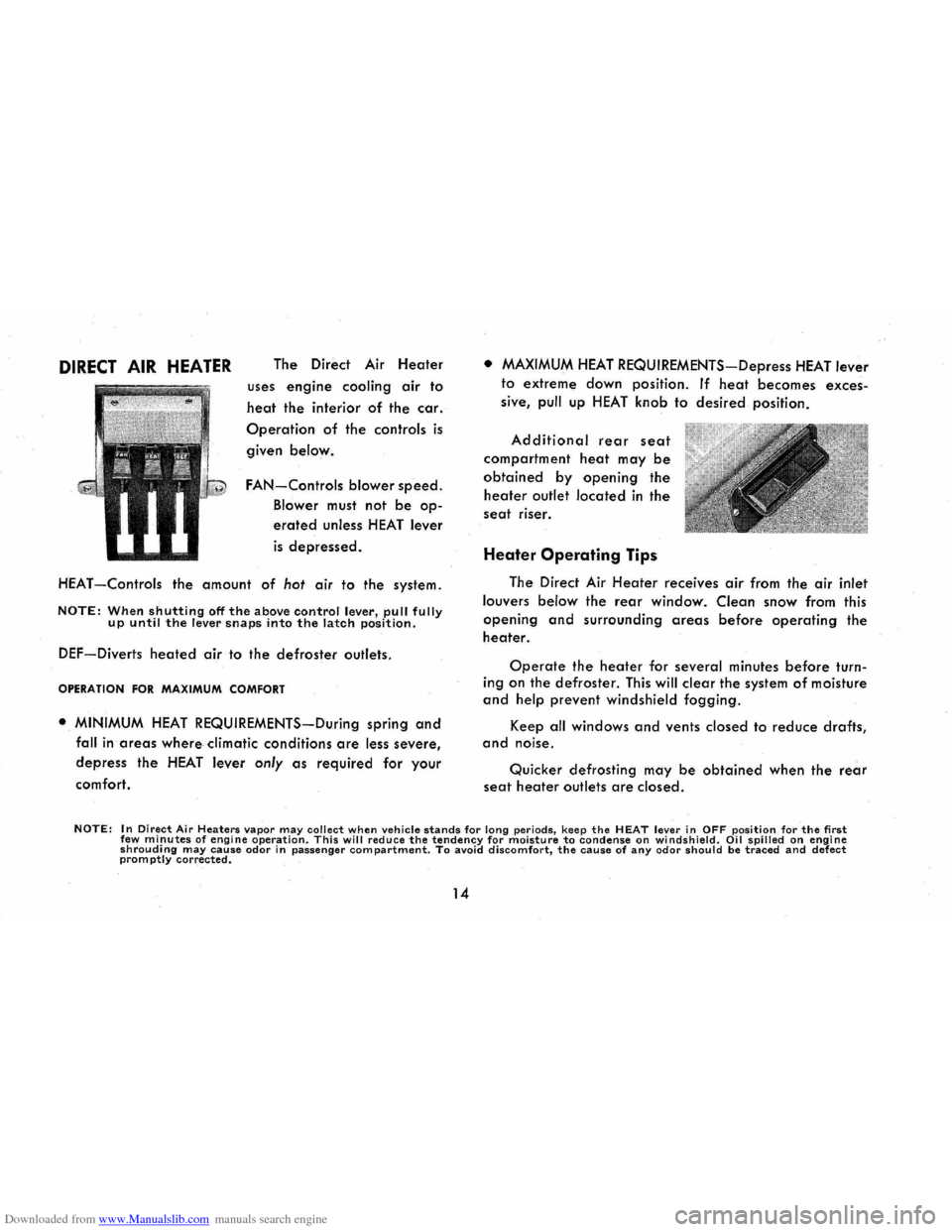
Downloaded from www.Manualslib.com manuals search engine DIRECT AIR HEATER The Direct Air Heater
uses engine cooling air to
heat the interior of the car.
Operation of the controls is
given below.
FAN-Controls blower speed.
Blower must not be op
erated unless HEAT lever
is depressed.
HEAT
-Controls the amount of hot air to the system.
NOTE: When shutting off the above control lever, pull fully up until the lever snaps into the latch position.
DEF-Diverts heated air to the defroster outlets.
OPERATION FOR MAXIMUM COMFORT
• MINIMUM HEAT REQUIREMENTS-During spring and
fall in areas where climatic conditions are less severe,
depress the HEAT
lever only as required for your
comfort.
• MAXIMUM HEAT REQUIREMENTS-Depress HEAT lever
to extreme down position. If heat becomes exces
sive, pull up HEAT
knob to desired position.
Additional rear seat
compartment heat may be
obtained by opening the
heater outlet located in the
seat riser.
Heater Operating Tips
The Direct Air Heater receives air from the air inlet
louvers below the rear window. Clean snow from this
opening and surrounding areas before operating the
heater.
Operate the heater for several minutes before turn
ing on the defroster. This will clear the system of moisture
and help prevent windshield fogging.
Keep all windows and vents closed to reduce drafts, and noise.
Quicker defrosting may be obtained when the rear
seat heater outlets are closed.
NOTE: In Direct Air Heaters vapor may collect when vehicle stands for long periods, keep the HEAT lever in OFF position for the first few minutes of engine operation. This will reduce the tendency for moisture to condense on windshield. Oil spilled on engine shrouding may cause odor in passenger compartment. To avoid discomfort, the cause of any odor should be traced and defect prom ptly corrected.
14
Page 18 of 56
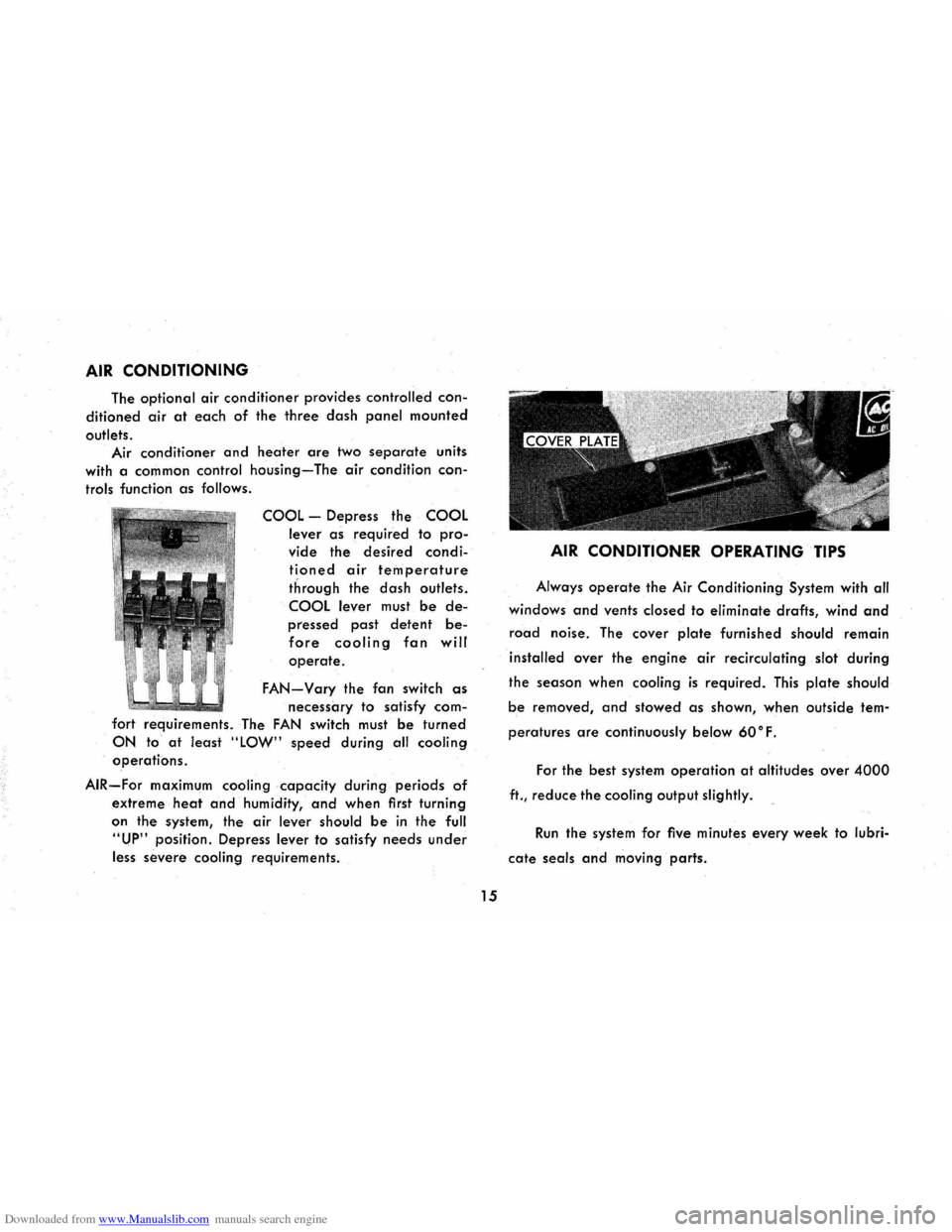
Downloaded from www.Manualslib.com manuals search engine AIR CONDITIONING
The optional air conditioner provides controlled con
ditioned air at each of the three dash panel mounted
outlets.
Air conditioner and heater are two separate units
with a common control housing-The air condition con
trols function as follows.
COOL -Depress the COOL
lever as required to pro
vide the desired condi
tioned air temperature
through the dash outlets.
COOL lever must be de
pressed past detent be
fore cooling fan will
operate.
FAN-Vary the fan switch as
necessary
to satisfy com
fort requirements. The FAN switch must be turned
ON to at least "LOW" speed during all cooling
operations.
AIR-For maximum cooling capacity during periods of
extreme heat and humidity, and when first turning
on the system, the air lever should be in the full
"UP" position. Depress lever to satisfy needs under
less severe cooling requirements.
15
AIR CONDITIONER OPERATING TIPS
Always operate the Air Conditioning System with all
windows and vents closed to eliminate drafts, wind and
road noise. The cover plate furnished should remain
installed over the engine air recirculating slot during
the season when cooling is required. This plate should
be removed, and stowed as shown, when outside tem
peratures are continuously below 600 F.
For the best system operation at altitudes over 4000
ft., reduce the cooling output slightly.
Run the system for five minutes every week to lubri
cate seals and moving parts.
Page 19 of 56
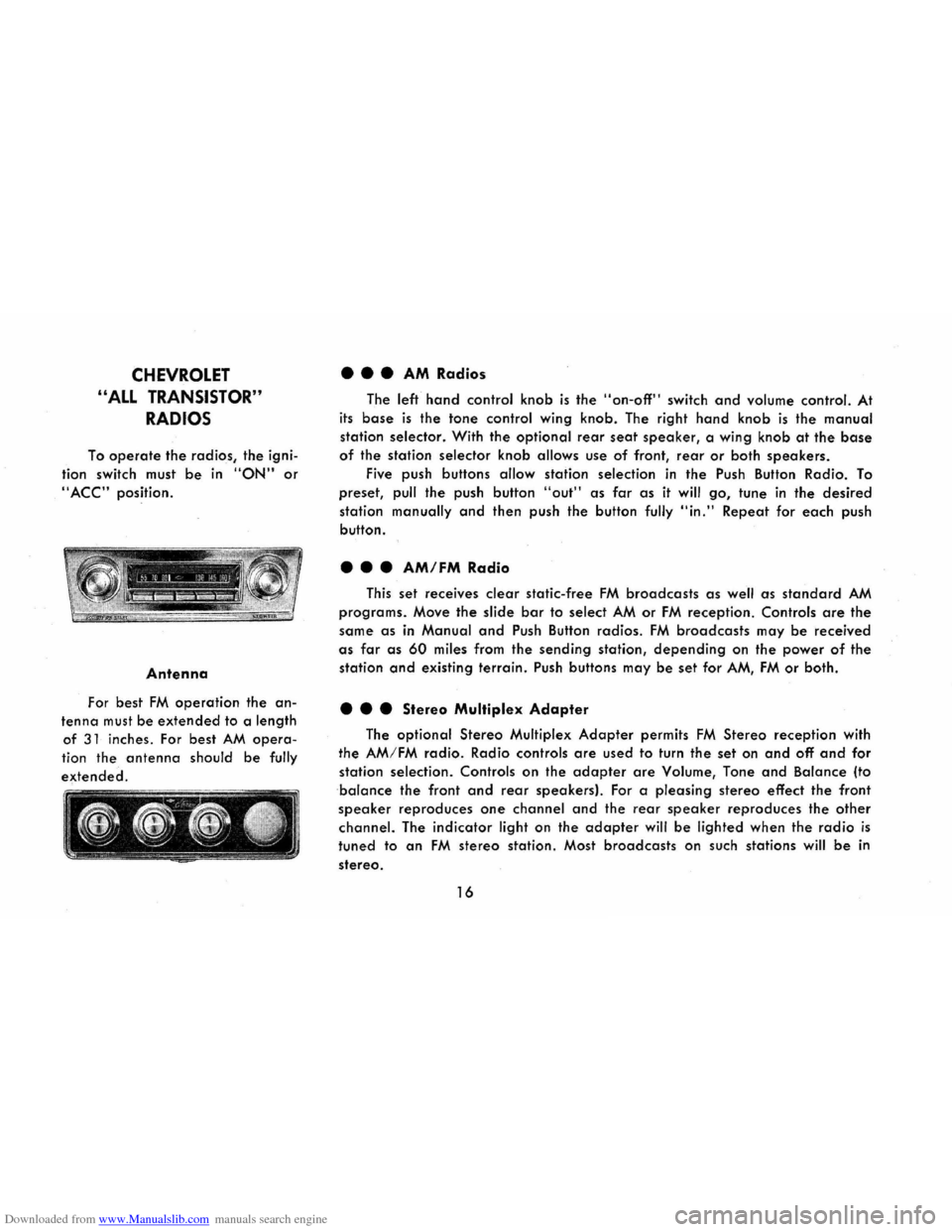
Downloaded from www.Manualslib.com manuals search engine CHEVROLET
"ALL TRANSISTOR"
RADIOS
To operate the radios, the igni
tion switch must
be in "ON" or
"ACC" position.
Antenna
For best FM operation the an
tenna must be extended to a length
of 31 inches. For best AM opera
tion
the antenna should be fully
extended.
••• AM Radios
The left hand control knob is the "on-off" switch and volume control. At
its base is the tone control wing knob. The right hand knob is the manual
station selector. With
the optional rear seat speaker, a wing knob at the base
of the station selector knob allows use of front, rear or both speakers.
Five push buttons allow station selection in the Push Button Radio. To
preset, pull the push button "out" as far as it will go, tune in the desired
station manually and then push the button fully "in." Repeat for each push
button.
• • • AMI FM Radio
This set receives clear static-free FM broadcasts as well as standard AM
programs. Move the slide bar to select AM or FM reception. Controls are the
same as in Manual and Push Button radios. FM broadcasts may be received
as far as 60 miles from the sending station, depending on the power of the
station and existing terrain. Push buttons may be set for AM, FM or both.
• • • Stereo Multiplex Adapter
The optional Stereo Multiplex Adapter permits FM Stereo reception with
the AM/FM
radio. Radio controls are used to turn the set on and off and for
station selection. Controls on
the adapter are Volume, Tone and Balance (to
-balance the front and rear speakers!. For a pleasing stereo effect the front
speaker reproduces one channel and the rear speaker reproduces the other
channel. The indicator light on the adapter will be lighted when the radio is
tuned to an FM stereo station. Most broadcasts on such stations will be in
stereo.
16
Page 20 of 56
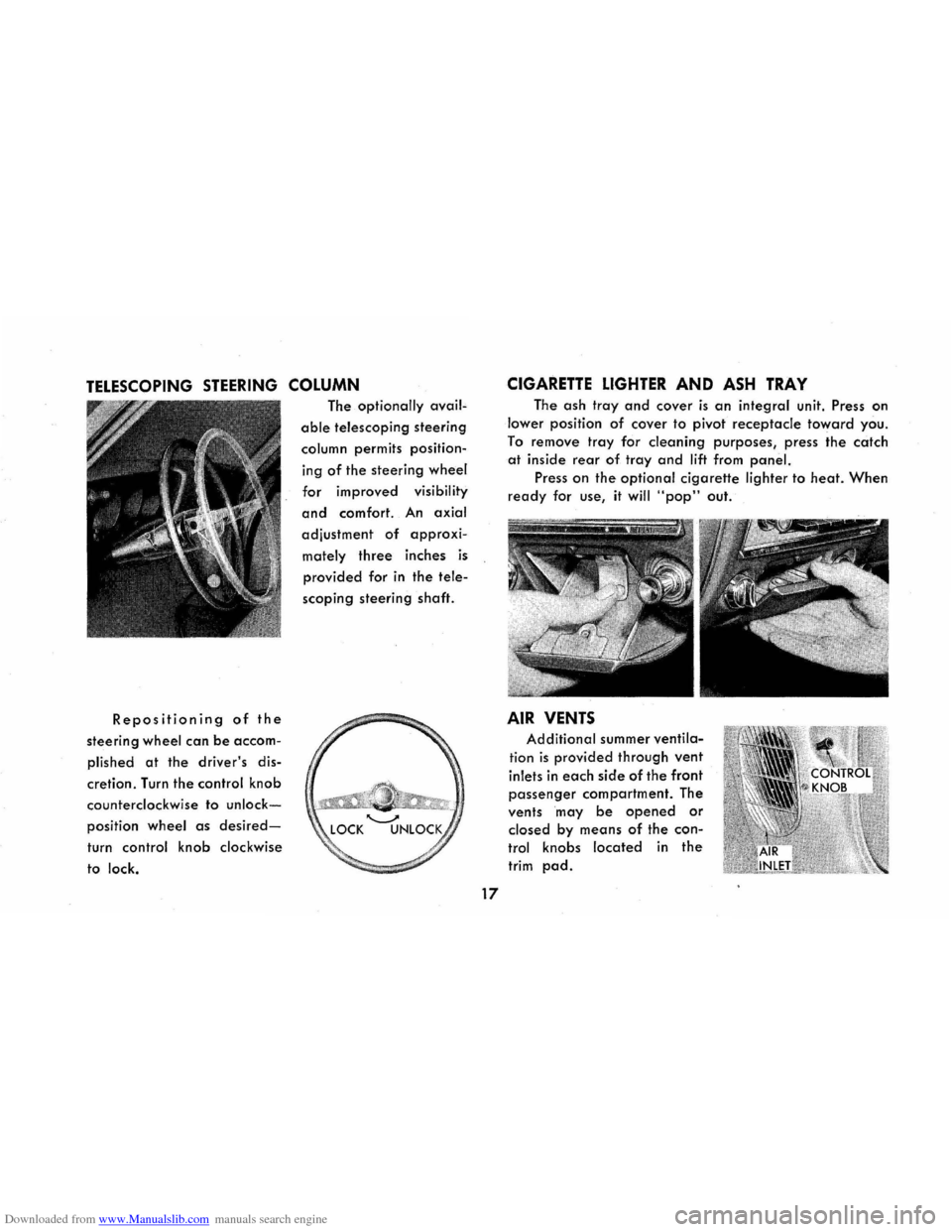
Downloaded from www.Manualslib.com manuals search engine TELESCOPING STEERING COLUMN
Repositioning of the
steering wheel can be accom
plished at the driver's dis
cretion.
Turn the control knob
counterclockwise to
unlock
position wheel as desired
turn control knob clockwise
to
lock.
The optionally avail
able telescoping steering
column permits position
ing
of the steering wheel
for improved visibility
and comfort. An axial
adiustment of approxi
mately three inches is
provided for in the tele
scoping steering shaft.
17
CIGARETTE LIGHTER AND ASH TRAY
The ash tray and cover is an integral unit. Press on
lower position of cover to pivot receptacle toward you.
To remove tray for cleaning purposes, press the catch
at inside rear of tray and lift from panel.
Press on the optional cigarette lighter to heat. When
ready for use, it will "pop" out.
AIR VENTS
Additional summer ventila
tion is provided through vent
inlets in each side of the front
passenger compartment. The
vents may
be opened or
closed by means of the con
trol knobs located in the
trim pad.